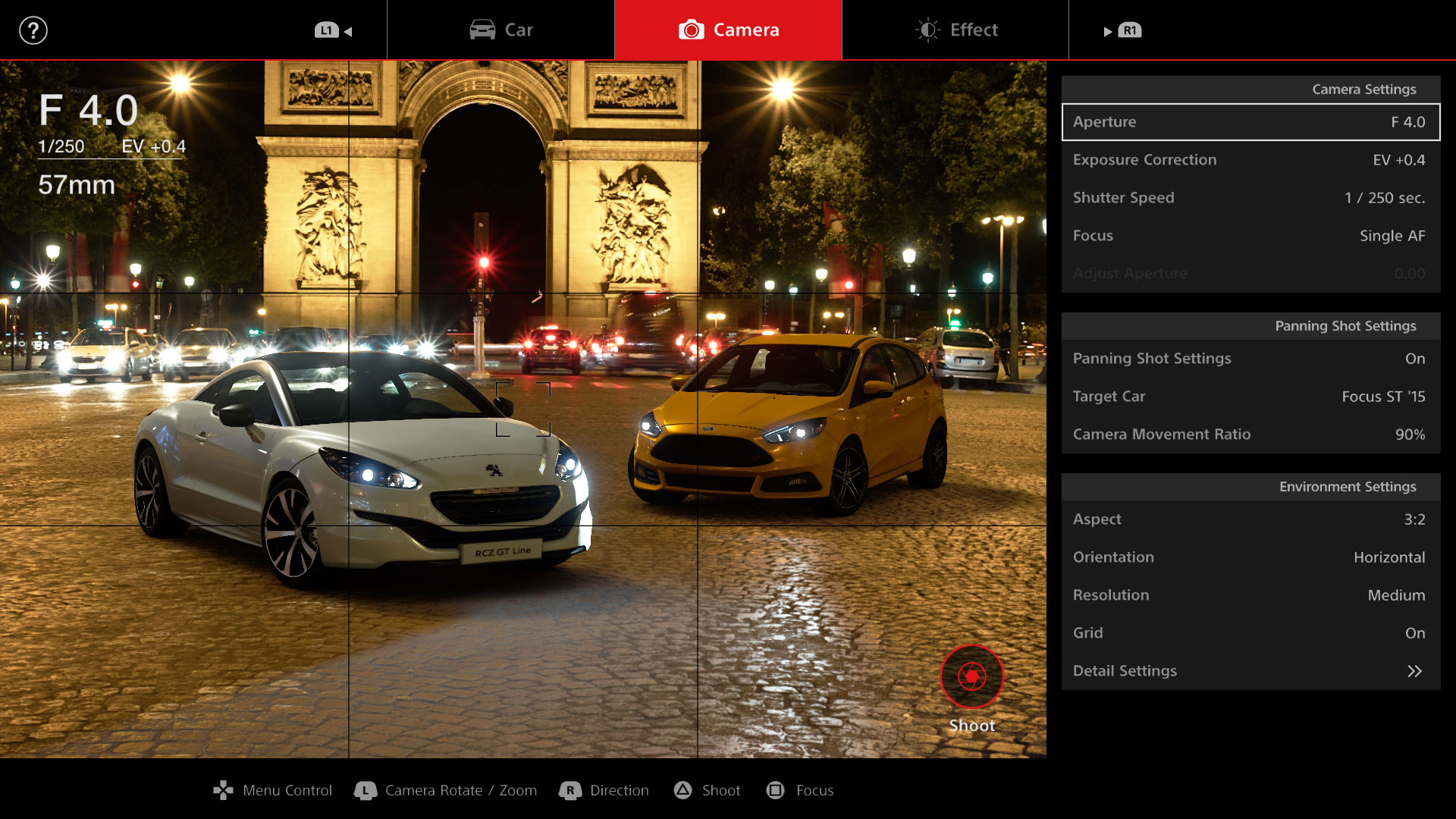α Series Resolution Quality and Realism Supports Real-Life Expressions in Gran Turismo
Gran Turismo Sport, the world-renowned racing simulator for PlayStation®4, delivers a global perspective with an unprecedented feeling of realism. And it is worthy to note that the Sony α camera actually has a significant role in supporting this realism. A good example of this is "Scapes," a mode that allows gamers to create unique photographs by positioning their favorite cars into real-life locations from around the world. The photography team's camera of choice when travelling around the globe to capture these real-life scenes is the full-frame mirrorless Sony α camera. Leading the team are Chikara Kitabatake, an automotive photographer renowned for capturing breathtaking moments on camera, and Hiroshi Kanzaki from Polyphony Digital Inc., the company that created Gran Turismo. The "α Universe Editorial Team" caught up with them to speak about how Gran Turismo's global userbase is fully engaging with Scapes, and to learn the reasons behind why they chose the full-frame mirrorless α. As a bonus, I also got to listen to one or two tales from their shoots.
Hiroshi Kanzaki/Polyphony Digital Inc. (Left)
Gran Turismo Sport Scapes Production Team.
Chikara Kitabatake/Automotive Photographer (Right)
Born in 1957, Kitabatake worked as an automotive photographer covering the WEC, WRC, F1 between 1983 and 1990. Since 1991, he has mainly focused on creating catalogues, producing multiple examples for automobile manufacturers in Japan. Since 2016, he's been photographing around the world as part of the Scapes team for Gran Turismo Sport.
The mindset of car enthusiasts was at the forefront when the development of "Scapes" began. Now we are looking at specialist content that racing game users around the world will enjoy.
First, if you could explain a little about the background as to how "Scapes" came to be included in Gran Turismo?
Kanzaki: A large number of Gran Turismo (hereafter, GT) fans are car enthusiasts, and it's only natural that they would want to take cool photos of their favorite cars, so we included Scapes as a way to offer content to meet those needs.
Scapes is a mode that allows you to freely place realistically reproduced 3D models of vehicles into photographs of the real world. These real-life shots, which contain optical and spatial information, incorporate the most spectacular scenery from every region of the world, including iconic locations such as Mont Saint-Michel, the Grand Canyon and Kyoto, and so on. Even now, players from all over the world continue to enjoy creating stylish and alluring car shots by placing automobiles into various spectacular scenery. Scapes allows you to take photographs of your favorite car with precision timing that would be extremely difficult to do on a real-life circuit. We started development of this mode with the simple tenet that "car enthusiasts like to take car photos."
With Scapes, the actual location and timing of the shots are replicated virtually, which allows the user to alter the composition, exposure, focus position and other camera settings as they wish. It feels exactly as if you are at the location carrying out a photoshoot. In addition aesthetic car shots, you can also take panning shots, which give the sensation that the car is speeding in front of a blurred background. If you were to do this in real life, it's a method of photography that would require good equipment and a high level of skill, but with Scapes, you can start taking pictures fairly easily and keep retaking the shot until you have something you're satisfied with. This is why a large number of our users have been able to take some really impressive photos with Scapes.
Kitabatake: Yes, a lot of them have taken better photographs than me! With Scapes, the camera is in sync with the movement of the car, so you can take much better photos than compared to, say, if I was on location taking a panning shot. What surprised me when I first tried Scapes was the level of expressiveness that the Production Team were pursuing.
When you take a panning shot on location, you need to move the camera as you follow the car, so obviously complete synchronization is impossible. The synchronization is about 90-95% at best. So, replicating that tiny, 5% to 10% bit of blur was really quite groundbreaking. Because if you sync it completely, it doesn't feel natural, and kind of looks artificial. This slight touch of blur that the Production Team was seeking adds tremendously to the realism.
Kanzaki: Since "realism" is our core goal, we always aim to create an image that is as close to what the human eye sees as possible. Choosing whether to use 90%-95% synchronization instead of complete synchronization was something that we debated as a team right to the last minute. It wasn't something that one person decided subjectively, it just kind of developed after sharing our thoughts and analyzing various expressions.
Kitabatake: You can also adjust blur width, right? There have been numerous times when I've tried taking a photo with Scapes and then thought this has way too much blur, so I just adjusted the percentage with the slider. I was amazed that you could do that. I then went on to make some small adjustments and, before I knew it, a ton of time had passed!
Kanzaki: I just picture those natural-looking expressions, so these are set as the default. The user then has the freedom to make those small adjustments as they wish.
Why did you decide to go with real-life shots instead of CG for the backgrounds?
Kanzaki: In GT6, the predecessor to GT Sport, we had a feature called "Photo Travel," which was kind of the forerunner to Scapes. However, it only had around five locations at the time, and all of the backgrounds were made using CG, so everything from the roads to the buildings had to be painstakingly created in detail. To be honest, it was too expensive and a time burden. That's why with Scapes we wanted to try to use real-life photographs.
This resulted in us having a far greater crop of locations to choose from. There are 1400 Scapes locations included in GT Sport that are enjoyed by our users. We captured more than 60,000,000 images, and you can also change the colors of your favorite cars and apply your own decals, so the possibilities are almost endless. You can also share your Scapes Photos with millions of other users, which I think has created a new type of photography community that we haven't seen before.
Kitabatake: At first though, we were kind of worried that users wouldn't take to it, weren't we?
Kanzaki: That's right. We didn't really know for sure if this would be something our users would enjoy or not. Although our aim was "envisioned reality," I was worried we would just be told that it's just a regular composite image. However, the reaction from users after they started using it was more positive than I could have imagined, which was quite moving.
Kitabatake: Yes, I had the same sort of uncertainties as Kanzaki-san while I was shooting. I've been a big fan of the GT series since the early days and knew a lot about the game, but I was worried if users would actually get enjoyment out of taking photos in the game. When I took on this role I thought, "What if the community rejects it?" but once GT Sport launched, and I heard that Scapes was a huge hit, my motivation went straight up. It gave me the push to try to shoot at even more varied locations and with better timing.
When shooting, we envision a scene with the car already there and considered a composition that is easy for the user to edit!
What kind of criteria do you have for selecting Scapes locations?
Kanzaki: Kitabatake-san has been involved with car magazine advertisements and catalogue photos for a long time and knows a lot of places where you can take cool pictures of cars, so I've gone to him for advice many a time now. The prerequisite for Scapes photos is that you have to be able to place the car in the center of that setting. Even with the most breathtaking scenery in the world, it's impossible to know for sure if you can actually place a car there, which is another way of saying if there's going to be enough space, without actually visiting the location. So, I always like to ask Kitabatake-san with his rich knowledge of these areas, first.
Kitabatake: Looking for surfaces to put the car on was the hardest part. There's a lot of beautiful, famous locations which just don't have the space to place a car. Many a time I've jokingly asked the Production Team to add a small ledge with CG just so I could add a car, but always get told "no" and reminded that these images should be natural with a base in reality. I can't argue with that!
It seems like that location side of things are left to Kitabatake-san, but were there any orders from the Production Team?
Kanzaki: Kazunori Yamauchi-san, the Series Producer for GT, told me to just pick a place I like, at a time I like, and take the photograph I like. I thought he was joking at first, so when I asked him again, he advised me to go somewhere that Kitabatake-san would like to take car pictures, and come back with some photos. That's kind of how it all started.
I wasn't given a specific location, so I just went to the place I most wanted to visit at first. That was "The Wave" in Arizona, America (below). For some reason, I really wanted to see the stratum, and I felt that the first location should be somewhere awe-inspiring to set a high bar going forward, and so that's why I chose it.
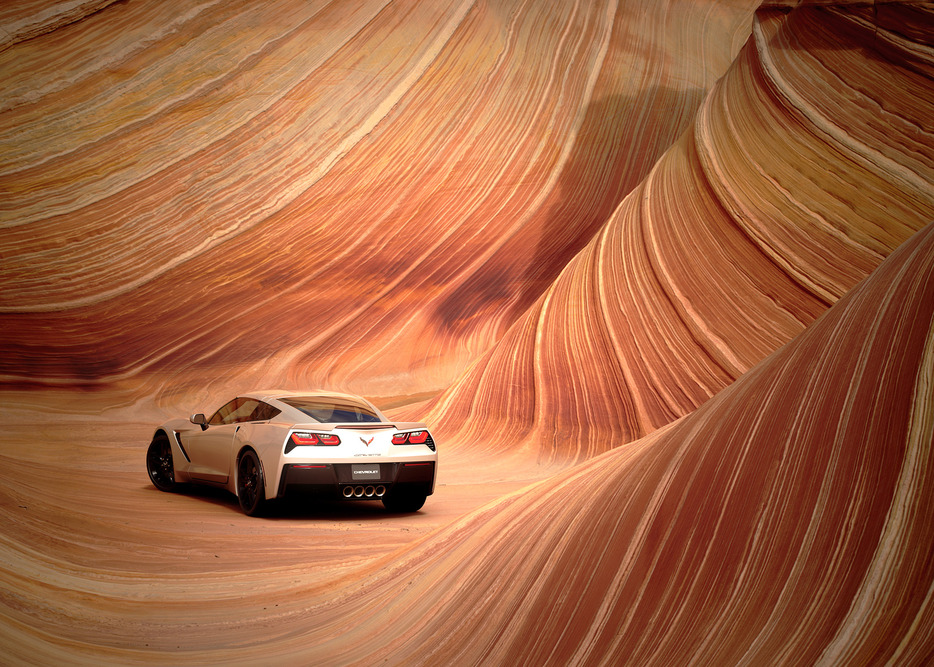
An unexplored region located at Vermilion Cliffs National Monument in Northern Arizona, USA. The layered reddish-brown sandstone layer draws a dynamic curve, creating a mysterious landscape.
Kitabatake: To protect the natural environment, only 20 visitors are permitted a day and to get in, you have to win a lottery. We would enter the walk-in lottery that was held each morning but had no luck. We repeatedly tried every day for six days, but still nothing, and then before we knew it was soon time to leave. There was very little time left, so I was thinking about what we would do if we actually did win the lottery. I asked a lady I'd met at the walk-in lottery if she wouldn’t mind going instead, so that we could head over straight away if things went well. In fact, her husband was a fan of GT and so kindly offered to go in our place. As luck would have it, she won!
I knew that the quality of any subsequent pictures would be determined by the quality of the very first shot, so I was determined to work hard to ensure that we started at a high level from the outset. In that sense, I was a little nervous as I knew the first shot had to be flawless.
I had looked at pictures of the location before leaving, so I knew that it had a surface in which to place a car, but I had to try and envision how the size of the car and background would fit together. When I got to the location, it felt somewhat narrower than what I was expecting. Before heading there, I had been keenly thinking about the shots I wanted to take, and I couldn't wait to get started, but it was tough going as few areas actually showed off the curves of the strata well. Our time was limited then, so if possible I'd love to give it another try and take an even better picture there!
It must have taken rather a long time to compile all of the locations?
Kanzaki: GT Sport launched in Autumn of 2017, and we began shooting in 2015, which means we shot 1400 scenes in two years. We are still currently conducting shoots, so I guess Kitabatake-san has also been hard at work on this project for over five years now.
Kitabatake: At the time, I was conducting around ten shoots a year, and each trip would take around two weeks. I've travelled to upwards of 60 countries, including locations that are yet to be included in the game. We would typically spend around two weeks travelling around each country, although one time I misjudged the scale of the map, which resulted in us having to drive 1200km in a single day while shooting!
When shooting catalogues for car manufacturers, I typically stay at a location for at least three days until I have optimal lighting conditions, but with Scapes shoots we are looking for variation, so that isn't possible. As such, during my initial discussions with the Production Team, we decided that we would stick first and foremost to the schedule no matter the weather. One of the Production Team people said to me, seeing as Gran Turismo means "To Travel," why shouldn't we approach these shoots in that way? So in the beginning, my emphasis was on working to the schedule no matter if it rained or whatever. I put together a schedule that would allow me as much time as possible to take pictures in the morning or evening when the lighting was most beautiful. There were lots of occasions where things didn't turn out as I had anticipated, but I was relieved to hear that these types of occasions also add to the variety of expressions we could offer users.
Incidentally, when GT Sport launched, I had finished what I had been assigned to do, so Polyphony approached me about doing more locations. From there, I decided to alter my approach a little for subsequent photoshoots, and now when I find a truly iconic location, I might sometimes spend three days shooting there.
Taking into account the image will be used in Scapes, are there any things you have to keep in mind when shooting?
Kitabatake: Ultimately, the photos that are being created are car shots, not landscape shots. So, what I try to do is to envision a car already in the scene and create a shot that would frame the car nicely. It's also essential to ensure that the framing is a touch loose and wide so that the user can easily adjust the composition. As a professional, this kind of lack of focus with the framing isn't something I'd usually accept. However, it's necessary because if you overload the frame, it ends up being difficult for the user to use
Kanzaki: If a composition is too predetermined it prevents the user from inserting the car into the image as they would like, so I asked Kitabatake-san to frame the shots a little loosely so that we can offer the users a greater degree of expression.
I heard you use the Full-Frame Mirrorless α Series on your shoots. Are α cameras used in any other area of production for GT other than Scapes?
Kanzaki: At PDI, we almost exclusively use the α7. That means the camera that is used to shoot the details on cars for creating CG is an α, and the camera that we use to scout locations with is also an α. Basically, all photography needed for the production of the GT series is shot using an α camera. We are using it in a wide variety of scenarios, so much so that we are developing our own original accessories and apps that support α to enable us to use it even more with the production of the GT series.
It's lightweight, compact and offers high-resolution, which is fantastic. The α was one of the first mirrorless interchangeable-lens cameras to provide higher resolutions, and this is a huge plus for us. If a car’s detail resolution, for example, is too blocky, then you can't check all of the tiny details, so the α series is crucial in helping us create a realistic view of the world in Gran Turismo.
Compatibility with CG makes the α stand out! Beautiful scenery with rich gradation that makes cars sparkle!
What are your thoughts on the α from your experience using it with Scapes?
Kitabatake: What makes the α stand out to me is that it has a much higher level of clarity than any camera I've ever used previously. I was genuinely shocked when I checked the image on its 4K HDR monitor. The color gradients are rich, and the resolution is fantastic. It's like looking into a different world.
Kanzaki: From a production side I felt the most significant advantage of the α is its compatibility with CG. The level of resolution is high, it draws stunning edges, and the colors are neutral in tone with no real quirks, so I think it's possibly the best camera for CG.
One such example is the abandoned building photo below. The CG car appears to blend in with the environment.
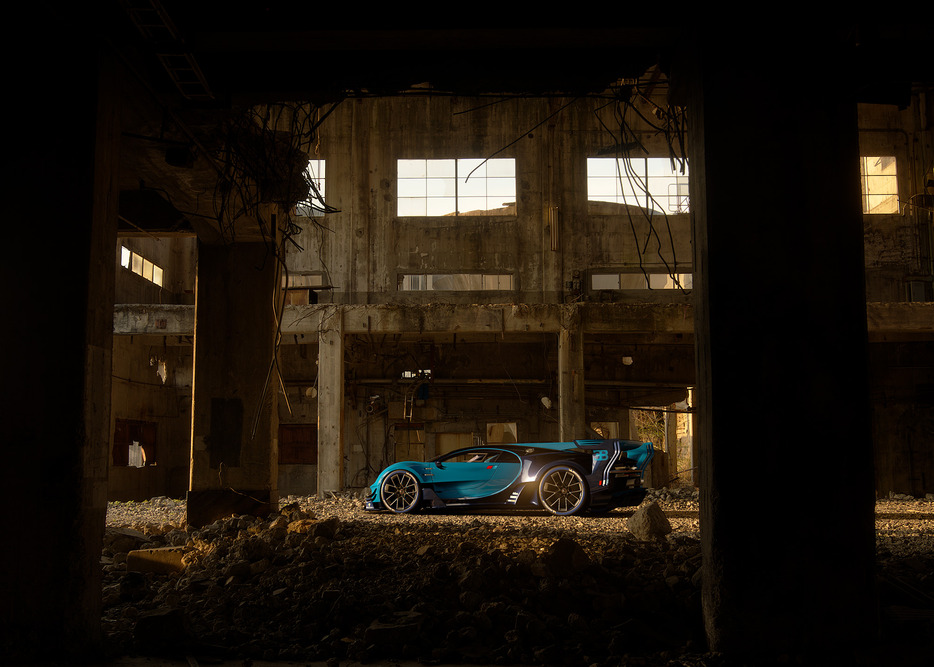
A former paper mill in Takahagi City, Ibaraki Prefecture. Several buildings have been left to decay, and they have such desolate beauty. It was also a popular location for television dramas and movies.
Kanzaki: The following photo of a backlit scene off the coastline of France is also exceptional. Often, the silhouette becomes blurry with this kind of lighting, but the α captures it with such crispness.
Kitabatake: I'd been involved with catalogue photography up until that point, so I hadn't had much experience with taking backlit photos. However, the Production Team tends to like using these kinds of scenes, so now I have many opportunities to take backlit shots. The α gives out a really beautiful flare effect with backlit shots. The Production Team also created an effect that puts fog on the car, so that's why it all blends together with the landscape.
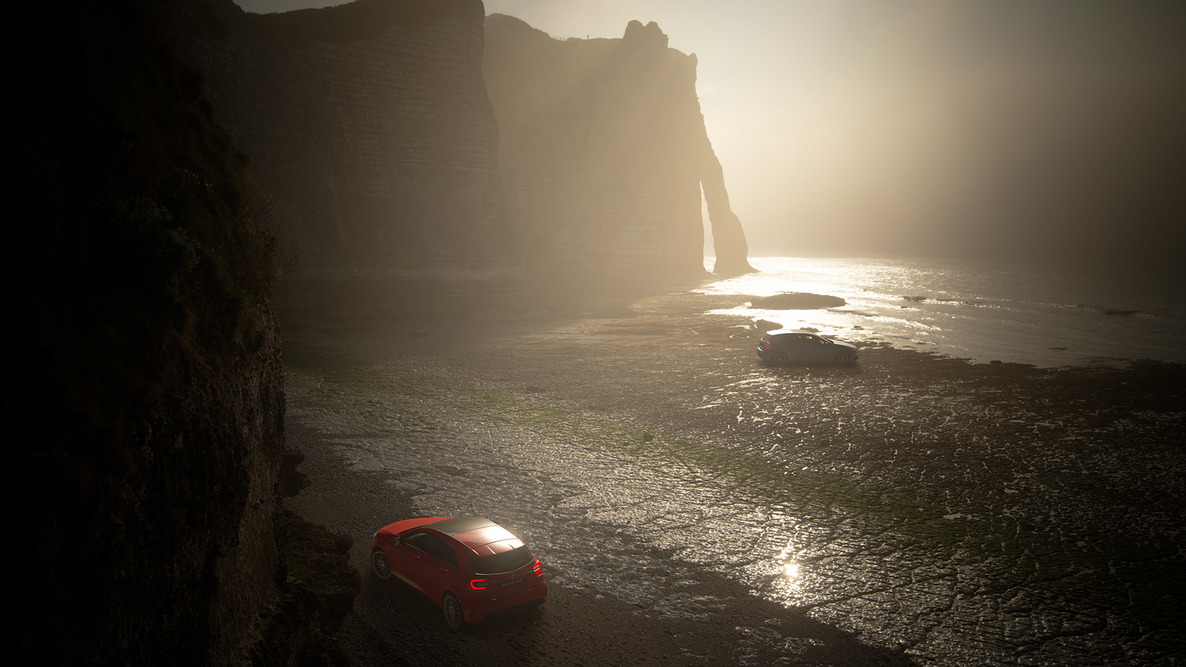
The coastline of Étretat, a resort town in Normandy. The contrast between the limestone cliffs exposed to the wind and rain and the sandy beach has been treasured by artists since ancient times.
Kanzaki: If you place a CG car in the image with no editing, then it will stick out from the rest of the image, so to avoid that, we asked for the development of a function which enables fog to be added. A similar process was also used for the image below taken at White Sands. We knew that there would be a number of situations that would require a tool to merge the car in with the landscapes, so we looked at the images Kitabatake-san took for us, and then tried to come up with functions as they were needed. To be honest, it requires a tremendous amount of effort, but there is undoubtedly an infinite number of expressions that can be explored, so I will continue to work on them carefully one at a time.
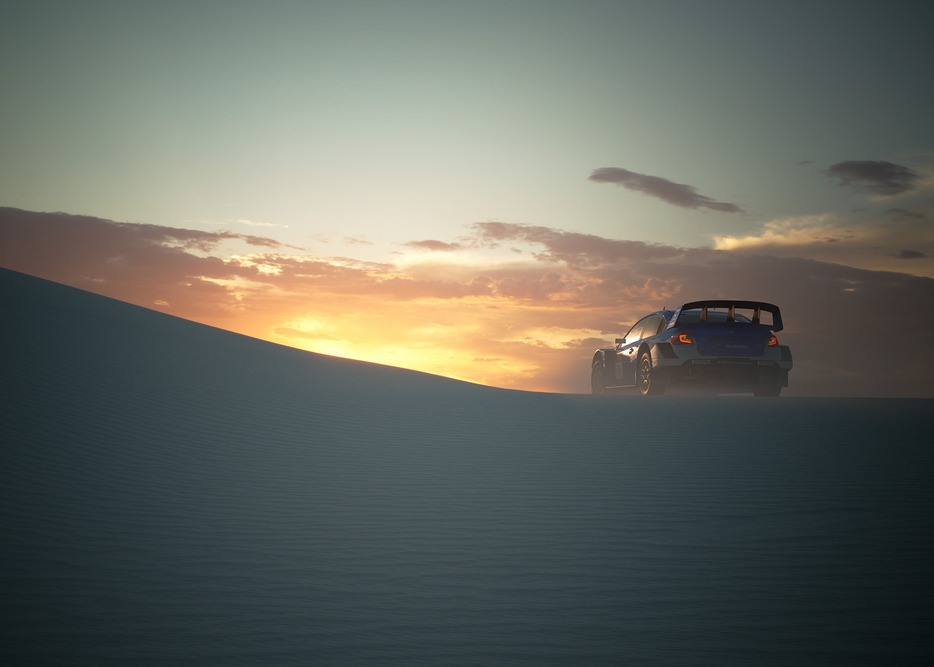
A vast sand dune area in New Mexico. Basin shaped white sand dunes composed of crystallized gypsum create a completely white landscape that sprawls over some 710 square kilometers.
Were there any locations that were particularly difficult to shoot?
Kitabatake: Shooting at Preikestolen (the Pulpit Rock) in Norway was problematic for several reasons. This was the main spot I had in mind when travelling around looking for locations, so I wanted to make sure that I captured it on a sunny day. However, the year I visited was the coldest summer in the last 50 years, and the weather was terrible and was overcast every day. On top of that, from the hotel to the site was about a two-hour walk up a mountain path. One day, the owner of the hotel mentioned to me that the weather forecast was looking good for the following day, so I woke up early and left the hotel at 3 a.m. However, it took too much time to get up the mountain path, and I didn't make it in time for the sunrise. Even if I had succeeded, the sun was obscured by clouds anyway. I thought, "I've got to do this all again tomorrow!" Anyway, I did go back, but what was waiting for me was a spectacular view of about 100 tourists on the cliff in their sleeping bags waiting for morning! This wasn't what I was expecting at all, and truthfully, I had resigned myself to giving up believing there was nothing I could have done.
But then the sun came out from the clouds again and the lighting conditions improved, so I thought to myself this is it! I gave the other staff the Japanese snacks I'd brought with me and told them to go to the cliff below and wake up all the people in their sleeping bags. The staff handed out the snacks and asked if they wouldn't mind helping us as we had travelled all the way from Japan for this shot. I had everyone move to the right side of the cliff first and then to the left side of the cliff. It took around a minute to take all the shots, and finally, I combined both sides to create a landscape without the people.

A steep cliff that rises 600m above the Lysefjorden below. There are no fences installed on this immense cliff, and the speculator view is like no other in the world.
Kanzaki: When we do a shoot for Scapes, we have to ensure that we have secured enough space to place a car. However, you can guarantee that with popular tourist spots such as world heritage sites there will be people there, so we often have to ask people if they wouldn't mind moving out of the way. It isn't always just people. On occasion, we have to move and clean up rubbish too. It's all just a part of achieving the goal of our shoots, and being able to show off cars against beautiful aesthetic backdrops.
Rotate the car to catch light accurately and think about how it combines with the background when taking the shot.
I heard that you are also enjoying Scapes, Kitabatake-san. Do you have any tips for shooting cool car pictures?
Kitabatake: Firstly, it's important to look at every part of the screen you are shooting, then rotate the car to try to catch the light as well as possible. There will always be reflections such as the sky or the ground on the body of the car, but by turning the car you can get an understanding of how the light will react in a particular situation. So, yes, first rotate the car to catch the light. From there, you can move the car around and alter its size to find the location that fits best with the background. I think these are pretty good tips for creating nice photos.
If you feel like you want to add a bit more, then I recommend trying a panning shot. Adjusting the shutter speed will change the flow of the background, and it's possible to create a variety of expressions. It's really quite amazing that you can do this. I take panning shots for catalogue shoots, but we need relatively large-scale equipment to sync the camera with the car, such as a crane, which we call a rig. With Scapes, you can easily do what in real-life would cost around a million yen to shoot, and the photos you can take are astonishingly good. It's impossible not to have fun with it.
Scapes is a fantastic mode that comes as close to actual photography as is humanly possible. It's packed with so many features that I haven't used all of them yet, and the expressions are almost endless. Please play around with the camera settings for yourself and see what you can come up with. It's also great for learning about cameras.
Isn't being able to share photos you think are cool with other users also a great feature?
Kitabatake: I dream that one day the users throughout the world will also be able to take Scapes location photos and share them in the game. If you live nearby a scenic location, then all you have to do is keep an eye on the weather and time, and you can go out and take some photographs. I hope that in the future, we won't just have photos from the Production Team, but also those that have been uploaded and shared by the game's users, and if we can create this interaction between our users, then it will add another level of enjoyment to Scapes.
In that case, it sounds like Scapes will continue to develop even further.
Kanzaki: In the future, I would like to pursue expressions that go beyond what is possible with standard photography and are more Scapes-like. Yet, to realize this dream, it's crucial to have an abundance of scenic locations. With car media and magazines, you are limited in your expressions as you can only shoot at locations where it is possible to place a car or where it can be driven. However, with Scapes, all you need is the space to place a car, so the possibilities for making the location or expression look cool are endless. I look forward to continuing my journey of finding locations that make cars look cool and stylish.
Of course, I'll be taking along the α on this journey. For location shots for GT Sport, we used the α7R III, but now the 61-megapixel A7R IV has been released, hasn't it? With Scapes, you need to frame and cut out the shot. And so, a higher pixel count would allow for more freedom with the composition of the car and the background. If this is something that we can accomplish, then I'm sure it will please not only myself but GT users all over the world. We have high expectations for the device, so I'm sure we will start shooting with α7R IV before too long. Similarly, I hope that you all continue to pay attention to the ongoing evolution of Scapes.

